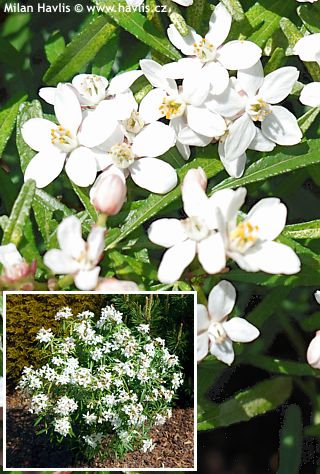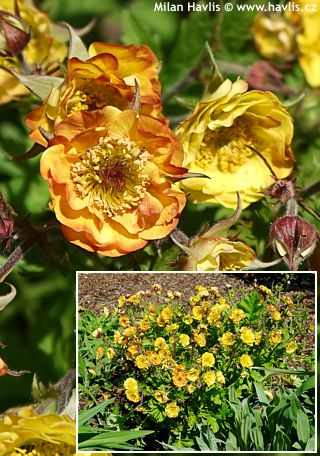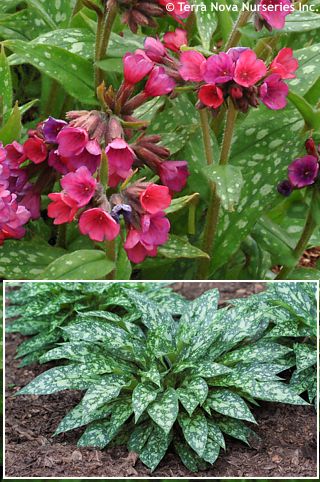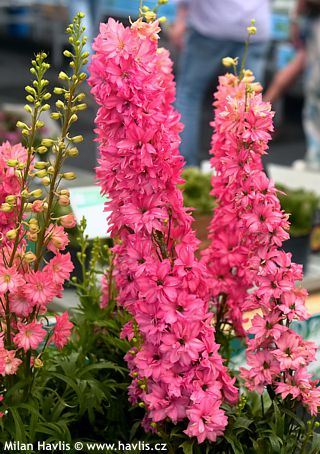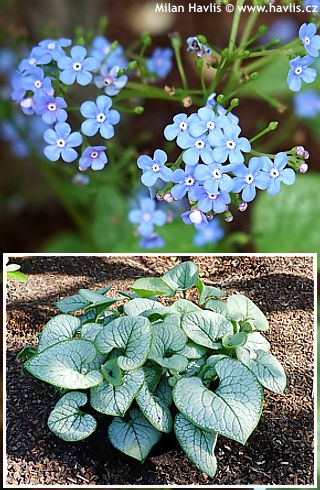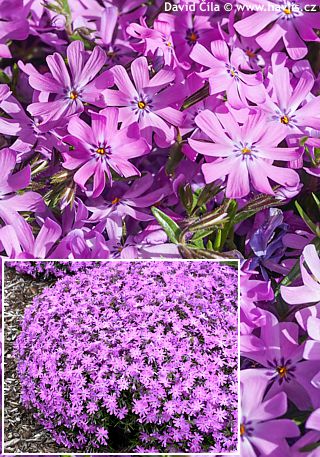New in assortment - fern-leaved bleeding heart (Dicentra 'PINK DIAMONDS')11.6.2025
Pink Diamonds is one of the subsequent hybrid bleeding heart varieties, developed from Firecracker. It was bred by Hans A. Hansen from Walters Gardens in Michigan, USA, with patent PP32380 granted in 2020. The plant features dense growth and beautiful, delicate, pale green to blue-green, matte foliage, resembling the leaves of Fernleaf Peony (Paeonia tenuifolia) or some Corydalis species. From mid-spring appear reddish stems topped with pastel pink, bell-like flowers. The blooming period can last up to four months, making this an exceptionally long-flowering cultivar. Thanks to its lush foliage, this variety remains visually appealing even outside its flowering season, making it a luxurious element in any garden composition.
Unlike the common bleeding hearts found in Czech gardens, these hybrid varieties require full sun and well-drained soil, as they prefer drier conditions. They should be treated like semi-drought-resistant rock garden plants—both in terms of aesthetic use and growing conditions. They favour slightly acidic soil and are not lime-loving. While they require well-drained soil with some moisture, they are not prairie plants or succulents capable of surviving prolonged droughts. They excel in cold climates and are hardy down to -40°C (USDA zone 3). They can also be grown in large containers with good drainage. The plant is mildly toxic, so caution is advised when handling it.
Last update 11-06-2025
New in assortment - Alpine star (Leontopodium alpinum 'Berghman' BLOSSOM OF SNOW)10.6.2025
BLOSSOM OF SNOW is a Belgian cultivar of edelweiss, selected by Herman Berghman from Asse, Belgium. Compared to the botanical species and other previously known varieties, it stands out with taller stems and larger flower heads, measuring 5–6 cm in diameter. They are light green, but due to the abundance of white hairs, they appear silvery – a protective adaptation that shields the plant from extreme cold, strong sunlight, and dehydration. Thanks to this resilience, it thrives in conditions where most plants would struggle. Blooming begins in June or July and may last until August.
Botanically speaking, these star-shaped, silvery-white structures are not actual flowers but rather protective bracts that surround tiny yellowish-white florets. The stems rise up to 30 cm once fully established in the garden, making it suitable as a cut flower as well. Its narrow, lance-shaped leaves are also delicately hairy, giving them the same silvery appearance. The cultivar is patented under PP29106 (USA – 2018) and 49517 (EU – 2018).
Due to its compact growth habit, edelweiss is ideal for rock gardens, alpine landscapes, or as a symbolic centerpiece in mountain-themed flower beds. Its silvery surface lends it an almost magical, mysterious beauty, which becomes particularly striking in sunny locations. When sunlight touches its fine hairs, it creates a velvety shimmer, making it appear like a natural work of art.
Edelweiss has a storied history, as it was traditionally used as a medicinal herb, especially for respiratory ailments and stomach issues. Today, its extracts are utilized in cosmetics, containing antioxidants and protective compounds that shield the skin from UV radiation. This plant is low-mainenance but requires specific conditions. It should be placed in a sunny location with well-drained soil, preferably lime-based. Watering should be moderate, as it dislikes excessive moisture. It thrives in poor, rocky soils with good drainage. Propagation is best done via seeds, which benefit from stratification. Edelweiss is fully hardy, enduring temperatures as low as -30°C (USDA zone 5) or even lower, making it an ideal plant for alpine conditions.
Last update 10-06-2025
New in assortment - houseleek (Sempervivum 'TOETIE FROETIES')9.6.2025
When I first saw the Toetie Froetie® houseleek series at the Plantarium horticultural fair, I believe it was in 2019, their display fascinated me just like everyone who passed by. The composition, featuring a dry tree with a charming little house nestled in its branches, looked like a miniature landscape straight out of a fantasy world – only Frodo was missing 😊
And then there was the breathtaking array of colourful houseleeks planted all around, even attached to the dry tree trunks – an absolutely stunning sight, and I’m not even a houseleek collector. The series includes many varieties, blending all possible leaf colours: yellow, chartreuse, pale and deep green, blue-green, even olive green, greyish to silvery hues, and various shades of red, reaching deep maroon tones. Some leaves are solid-coloured, but more often they have contrastingly tinted tips, and sometimes the colours gradually blend toward the leaf base. And they change throughout the season.
Each plant blooms a little differently. Most commonly, they develop upright, very thick flower stems, topped with star-shaped flowers in white, yellow, red, or purple. Flowering begins in mid-summer. Some low-growing, ground-covering types produce flowers just above their leaf rosettes, like stonecrops. The mother plant, once it has flowered, dies (its similarity to succulents like agave is no coincidence). However, before withering, it produces enough offshoots with young plants that continue to grow.
Houseleek is incredibly easy to grow. Simply plant it in gritty, well-draining soil under full sun, and it will thrive with minimal care. No special requirements. Fertilization is optional – use it if you want larger plants and faster spreading, but it is not necessary for healthy growth. Houseleek spreads gradually, producing small, spherical offshoots attached by thin, wiry stems. These dry out once the new plant touches the soil and has grown large enough to establish its own roots. Houseleek is typically very hardy, tolerating temperatures down to at least -34 °C (USDA Zone 4). However, some species and cultivars may be either more resilient or slightly less cold-tolerant than others.
Apart from specialist growers and collectors, the current trade practice among most European suppliers is to sell plants in mixed trays, often without variety names. To differentiate them here, we list them by colour, attaching a photograph of each plant so you can see exactly what we are selling. This way, you can place an order for the specific plant you want, based on the picture provided.
Last update 09-06-2025
New in assortment - coral bells (Heuchera PINK PANTHER®)5.6.2025
Much like the legendary diamond, Pink Panther coral bells is an absolute stunner. This richly coloured perennial boasts leaves in vibrant pink shades, with purple undertones, metallic reflections, and deep burgundy veins. Botanically, its leaves are round, but thanks to their prominent lobed edges, they can resemble palmate leaves. While not overly large, the plant produces enough foliage to form a lush clump and a reliable ground cover. As the leaves mature, their colours intensify, gaining an even glossier sheen.
The plant reaches about 30 cm in height and 40 cm in width (when in leaf), while its flowering stems appear around mid-summer, reaching up to 60 cm in height. They are rather delicate and unobtrusive, though. The flower spikes take the form of upright racemes, sometimes mistakenly described as terminal panicles. These slender stems bear tiny, pale pink blossoms, which you can cut and use to decorate bouquets. This spectacular variety was bred by American breeder Hans A. Hansen at Walters Gardens, Michigan, and has been patented under PP31224 (USA) since 2019.
Coral bells are hardy perennials, mainly used as ground covers, however, they are excellent companions to plants with other textures, especially when mass planted. They prefer lightly shaded locations and evenly moist, nutrient-rich soil—soil pH does not matter. With occasional watering, they can tolerate full sun, except for light-colored varieties, unless specifically bred for sun exposure. They can even grow in shade, though their colors will be less vivid. In early spring, simply trim all leaves, allowing fresh new foliage to emerge. Fertilization is not required but significantly enhances their appearance and vigour. They are hardy to approximately -34 °C (USDA zone 4) and can be grown in outdoor containers as well.
Last update 05-06-2025
New in assortment - long-flowered lindelofia (Lindelofia longiflora)4.6.2025
Lindelofia longiflora is a beautiful and distinctive perennial from subalpine to subarctic regions, yet ironically, it is not a rock garden plant. It bears long inflorescences called scorpioid cymes, similar to those found in forget-me-not or lungwort. Lindelofia’s flowers truly resemble a blend of both. Each flower has five almost rounded petals, a deep, prominent calyx, and initially appears slightly bell-shaped, like lungwort. Later, they open flat, resembling forget-me-nots. The flowers are tiny, barely 1 cm across, yet dazzlingly colored like a stormy blue sky, with a purple center. They are nectar-rich, attracting bees that adore them. Flowering lasts a long time, typically starting in late May and continuing through July, either continuously or in two flushes.
The leaves are narrowly lanceolate, vivid green, but slightly hairy, which gives them a silver sheen. They are deciduous. The stems are soft and fleshy, also covered in fine hairs thus appearing silvery, and they may be slightly crooked. Lindelofia looks stunning in bark-mulched garden beds, among dwarf conifers, or alongside delicately flowering perennials in pastel colors, such as Saponaria or Iberis. For contrast, pairing it with shade-loving broad-leaf perennials like Brunnera or Heuchera in muted tones creates an eye-catching composition.
There is a common belief that Lindelofia longiflora is a synonym for Cynoglossum nervosum, known in English as Himalayan hound’s tongue. However, closer analysis and distribution records suggest differences. Cynoglossum nervosum has wider leaves with more pronounced veins and shorter inflorescences. It is found in China, whereas Lindelofia longiflora originates from northern Pakistan to Nepal. Lindelofia’s leaves are significantly softer to the touch due to fine hairs.
Lindelofia grows in places with intense sunlight during the day but cooler nights, allowing it to absorb moisture from the soil, even if water is scarce. Still, unlike dry alpine zones, Lindelofia grows where low trees and dwarf pines create dappled shade which creates an ideal environment protecting it from all-day direct sunlight. It needs well-drained yet moist, humus-rich soil, so occasional fertilizing is recommended.
Before winter, the plant’s above-ground parts disappear completely, making it seem as though it has perished, but it is only dormant and will emerge again in spring. Lindelofia withstands temperatures as low as -30°C (USDA zone 5) and according to some Canadian sources, possibly even -34 °C, though this has not been verified.
Last update 04-06-2025
New in assortment - great masterwort (Astrantia major 'PINK PRIDE')2.6.2025
Pink Pride is one of the more vividly coloured masterwort varieties, celebrated for both its flower appeal and ease of cultivation. It is a medium-tall perennial with blooms in soft purple to antique pink tones, reminiscent of Scabiosa-like flower heads. Interestingly, its most striking feature is the radiating bracts, from whose center short flower stems emerge, forming a rounded, dome-like cluster of tiny true flowers. Its floral structure is charmingly referred to as a “pincushion”. Flowering begins in June and lasts 4 to 6 weeks, with sturdy stems reaching about 70 cm in height.
Another striking feature is its broad, palmate leaves, which provide visual interest even before flowering begins. These deciduous, bright green, slightly glossy leaves have less conspicuous notches near their tips. If they appear tired after the first bloom, simply cut the entire clump back, and within a few weeks, new, lush foliage will emerge, ready for a second flowering in late summer.
Masterwort is a reliable and trouble-free perennial that is generally unpalatable to pests. It likes light shade or filtered sunlight, but will do great in full sun, too, if watered occasionally – it hates drying out completely. Some varieties may self-seed readily so unless you want it to spread on its own, remove spent flowers immediately to prevent seeds from ripening. Masterwort likes nutritious, moist soils of preferably neutral to alkaline pH, but once established it tolerates short dry spells. Fully hardy to approx. -34 °C. (USDA zone 4).
Last update 02-06-2025
New in assortment - coral bells (Heuchera 'Ifhemul' INDIAN SUMMER MULBERRY)30.5.2025
MULBERRY is a heuchera from the Indian Summer series, and its name refers to the mulberry fruit. Do you know it? It’s deep purple to almost black, but when you crush it, it bursts with a rich purple-red, sweet juice—just like the color of this stunning plant’s leaves. The foliage is intense purple, with deep maroon to black veining and a pinkish purple underside. The leaves are palmate, shallowly lobed, slightly wavy, highly glossy, and semi-evergreen, enduring mild winters without damage, making them a standout in the garden even deep into winter. It grows at a moderate pace, forming a compact, sturdy clump and spreading into lush cushions of dense foliage. From late spring until mid-summer small, less conspicuous flowers appear atop thin stems. This variety is protected under patents 58123 (EU – 2021) and PP32045 (USA – 2020).
Coral bells are hardy perennials, mainly used as ground covers, however, they are excellent companions to plants with other textures, especially when mass planted. They prefer lightly shaded locations and evenly moist, nutrient-rich soil—soil pH does not matter. With occasional watering, they can tolerate full sun, except for light-colored varieties, unless specifically bred for sun exposure. They can even grow in shade, though their colors will be less vivid. In early spring, simply trim all leaves, allowing fresh new foliage to emerge. Fertilization is not required but significantly enhances their appearance and vigour. They are hardy to approximately -34 °C (USDA zone 4) and can be grown in outdoor containers as well.
Last update 30-05-2025
New in assortment - sundrops (Oenothera 'Innoeno131' LEMON DROP)29.5.2025
LEMON DROP as an evening primrose variety is the perfect example of a mysterious origin – its narrow leaves, compact growth, and brilliantly coloured flowers have no clear botanical explanation. But who cares? It’s simply irresistible! This low-growing variety has a sprawling habit, similar in height and growth style to Oenothera speciosa, meaning it spreads along the ground with short, well-branched, partly red stems. Its deciduous leaves are bright green, narrowly lanceolate, measuring 4–5 cm long and only about half a centimeter wide.
Its flowers are bright yellow, like the fresh peel of a ripe lemon, consisting of four elongated, heart-shaped petals with a shallowly notched tip. They open for only a few days, after which new ones bloom. These hybrid evening primroses are highly valued for their long flowering period, stretching from early June to September – how amazing is that?
They make an excellent summer ground cover and border plant alongside other drought-resistant perennials, such as verbena, sea holly, curry plant, or leadwort. The variety was bred by Silvia Hofmann in Gensingen, Germany, as a cross between hybrid varieties African Sun and Narrow Grey Leaved. It is protected by patents No. 20476 (EU – 2007) and PP16393 (USA – 2006).
How to grow hybrid sundrops with narrow leaves
🌱 Soil: Regular garden soil, well-draining, not too wet, pH value is not a concern.
💧 Watering: Once established, it handles dry periods well but avoid waterlogging.
🌞 Sunlight: Full sun is ideal for healthy growth.
🌿 Fertilization: From late May to late summer.
✂️ Maintenance: In spring, remove all above-ground parts.
❄️ Frost tolerance: Hardy down to −29 °C (USDA zone 5).
Evening primrose LEMON DROP is a fantastic choice for gardens seeking vivid colors and low-maintenance beauty. Once planted, it will reward you every summer with its lemon-yellow blossoms.
Last update 29-05-2025
New in assortment - locust (Robinia x margaretta 'GEORGIA DA TORINO')28.5.2025
Georgia da Torino is considered an improved version of the highly successful Casque Rouge locust cultivar. It was bred by Professor Maurizio Ceruti from Italy, who named it after his wife Giorgia and introduced it in 2016. This is a stunning tree with an airy canopy packed with attractive foliage and a spectacular display of deep pink flowers from late May to June. The flowers are arranged in 15–25 cm long racemes composed of pea-like (butterfly-shaped) blossoms, with a dark golden-brown flame adorning their throats. The tree produces an abundance of flowers and occasionally reblooms in summer but the flowering is rather scarce. You can encourage a second bloom though by pruning the tree after its first flowering in June.
The deciduous leaves are pinnate, medium green, typical of black locusts. Since new branches and leaves continue to grow until autumn, the tree maintains fresh green foliage until leaf drop. The canopy becomes almost spherical with age. It is quite regular in shape and provides so-called filtered sunlight, allowing for the cultivation of many other plants beneath it that do not require full sun. The ultimate height in maturity is estimated between 8 and 10 meters. The branches are far less thorny than those of the original black locust and not as brittle as those of Casque Rouge, making the tree strong and wind resistant.
Black locust prefers well-drained, poor soils and once established, tolerates long periods of drought. On the other hand, in wet and heavy soil, it has minimal chances of survival. Staking the trunk to a strong support is crucial for at least three years after planting, but we recommend keeping it secured for at least five years to ensure strong trunk development. Annual pruning in early spring before the buds begin to swell helps strengthen and densify the crown, though it is not necessary. Fully hardy to at least -34 °C (USDA 4).
Last update 28-05-2025
New in assortment - hybrid meadow clary (Salvia FASHIONISTA™ 'MOULIN ROUGE')27.5.2025
Do you know Moulin Rouge? It is an iconic Parisian cabaret founded in 1889, which became a symbol of the Belle Époque thanks to its extravagant parties and famous can-can dance. Its provocative atmosphere contributed to its reputation as a "den of vice," but at the same time, it was a cultural beacon where artists, writers, and intellectuals gathered. After a fire in 1915, it was reopened and gradually evolved into a prestigious venue, hosting stars like Edith Piaf and Frank Sinatra. Today, Moulin Rouge is a popular tourist attraction that offers spectacular shows while preserving the charm of Parisian history.
Moulin Rouge is also the cultivar name of this extravagant sage from the FASHIONISTA™ series, developed by American perennial specialist Hans A. Hansen from Walters Gardens in Michigan. It was created through a targeted breeding program, crossing meadow sage with other species to achieve the most vibrant flower colours and – drumrolls – mission accomplished, with flair! Here we have a botanical masterpiece! This variety took ordinary meadow clary, gave it a dramatic makeover, and sent it strutting onto the garden stage in neon-pink heels. The flowers of Moulin Rouge emerge from deep purple buds into a neon-bright pink hue. They are arranged in verticils on sturdy, well-branched, green stems, reaching 40-60 cm in height.
The leaves are medium green, heavily wrinkled, aromatic, and broadly lanceolate, forming a basal rosette. The plants are dense, and their stems with unopened buds droop before blooming—not due to water deficiency but as a natural growth pattern, straightening up as they flower. If the plant is cut back closely above the healthy basal leaves after blooming, it will regrow into a lush clump within a month and may even produce a second abundant flowering in mid-summer. It requires no special care. Under good conditions, a few vital seedlings may appear near the parent plant. Patent No. PP32387 was granted in 2020.
Sage will grow in almost any well-drained soil. For best results grow it in light, humus-rich, well-drained soil in full sun or light shade. It needs no fertilizing, only in very poor or compacted soils it will benefit from occasional feeding with a balanced fertilizer. Meadow clary requires warm and free-draining soil. In early spring remove all above-ground parts except for rosette of new or over-wintered, healthy leaves lying flat on the ground. It is perfectly hardy to about -34 °C (USDA zone 4) and will grow in outdoor pots, too.
Last update 27-05-2025
New in assortment - Fortune´s spindle (Euonymus fortunei 'Mickaela' SUMMER RUNNER)27.5.2025
SUMMER RUNNER is an Irish cultivar of Fortune's euonymus that was discovered in 1993 by Val Farrell in Rathmooney, near Dublin. It was a natural mutation of the Sunspot cultivar (from 1978) and Val originally named it after his wife, Mickaela. Later, it was given the trade name SUMMER RUNNER and was protected under patent no. PP16789, issued in 2006.
SUMMER RUNNER euonymus boasts a bright yellow colour in the centre of its small, evergreen leaves. These are firm, leathery, and margined deep green. Young leaves are very glossy. The twigs, too, are bright yellow, giving it a vibrant appearance. Yellow leaf areas take on pink to soft purple tones in autumn and winter. It grows mostly outward, creating dense, well-branched ground cover without empty spaces in the centre. Unlike older cultivars, it remains compact even without shaping, featuring shorter shoots. It works beautifully as an eye-catching cushion-like plant or as a lush, evergreen ground cover.
These spindles are especially valuable as underplanting for group arrangements, providing an attractive understory while allowing taller plants in the centre to draw attention. However, careful cultivar selection is advised to avoid excessive variegation or overly light-coloured foliage in combination with other taller shrubs. If placed near a vertical support, it can climb up and form a colourful evergreen wall or even a hedge.
Fortune’s spindle is easy to grow and thrives in sunlight or light shade. Pruning can be done anytime from spring to mid-summer. It prefers slightly acidic soil, though this is not essential. While it enjoys moisture, once established, it handles dry periods remarkably well. Fully hardy down to around -34 °C (USDA zone 4), it is also suitable for outdoor planters.
Last update 27-05-2025.
New in assortment - myrobalan (Prunus cerasifera 'PISSARDII')25.5.2025
Pissardii was the very first variety of purple-leaved cherry plum to reach Europe from the Orient, naturally named after its discoverer. Early in spring, before blackthorns and Japanese cherries begin to bloom, it bursts into a profusion of small, nearly white flowers with purplish calyxes, which from a distance can appear as light pink blossoms. In summer, pollinated flowers develop into small drupes with a deep purple skin. These are edible and, in some countries (England, France), are pitted and used as dessert garnishes—although I personally find other plum varieties more flavourful.
The deciduous leaves are elongated oval to broadly ovate and emerge only in the final stage of flowering. In spring, they shine in a radiant wine-red hue, as if viewed through a glass of fine claret in the sunlight. Later in the season, the colour slightly deepens yet retains a visible red tone—unlike the ‘Nigra’ variety, which is dark purple, nearly black.
In nurseries, it is shaped into a single-trunk standard tree or an attractive multi-stemmed form with a clean lower framework, though naturally, it forms densely branched shrubs with low branching and a broadly funnel-shaped silhouette. When grown as a tree, its crown gradually develops into a broad oval to nearly rounded shape. It is not a tall tree—typically reaching about six metres in height and width, though older specimens in parks with unrestricted root space can grow somewhat larger.
This vividly coloured, smaller tree is excellent for breaking up monotonous green landscapes or serving as a specimen complementing a differently coloured facade. It pairs well with urban greys and various shades of cream. It can be pruned and shaped freely, ideally right after flowering and no later than mid-summer. In England, pruning is widely practiced, and the tree is often planted in hedgerows, creating a striking colour statement.
Myrobalan is a very hardy and reliable tree. It is well-suited for urban and industrial environments, as it tolerates polluted air exceptionally well. It is not demanding in terms of soil, but for a truly beautiful tree with lush foliage and dense branching, plant it in slightly acidic soil that retains moisture without becoming waterlogged. In its early years, provide a few handfuls of slow-release organic fertiliser in early spring. Trees should be firmly staked for the first three to five years, and grass should not be allowed to grow over their roots. It is fully hardy down to approximately -40 °C (USDA zone 3) and is suitable even for mobile greenery in large containers.
Last update 23-05-2025
New in assortment - hybrid Japanese Encore azalea (Azalea x 'Conlet' AUTUMN CARNIVAL™)22.5.2025
AUTUMN CARNIVAL™ is a large-flowered hybrid Encore azalea, created by crossing the Watched and Fourth Of July varieties. It boasts large and vividly colored, bright pink flowers. They are simple, have slightly wavy edges, and measure six to eight centimeters in diameter. They first bloom in mid-May for about three weeks. Then the shrub gathers strength and produces new shoots, which begin blooming again around mid-August and continue until the first frost, without compromising the abundant set of spring buds. It grows at a moderate pace into a semi-spherical shrub, reaching slightly over one meter in both height and width. The evergreen leaves are dark green, broadly elliptical to oval, flat, and delicately fuzzy. Patent No. PP12111 was granted in 2001.
Azaleas can be shaped by pruning, ideally immediately after blooming, to allow time for flower buds to form for the next season. If you prune them, do not fertilize them to promote faster growth. Azaleas require light, acidic, highly permeable soil that is preferably constantly moist (but not waterlogged) and rich in iron and phosphorus. Use specialized fertilizers for rhododendrons and azaleas, or ericaceous plants. To retain soil moisture, it is best to keep them continuously mulched. The ideal planting soil mix consists of one-third peat, one-third decomposed leaves or lime-free compost, and one-third of refined local soil from the planting site. Azaleas develop shallow and fine roots slowly spreading sideways, so do not plant them too deep, and never in heavy, heavy or clay-based soil. If the leaves turn yellow or drop after winter, the plant has been placed in unsuitable, often waterlogged soil. Out of Encore azaleas we choose only those with guaranteed hardiness. AUTUMN CARNIVAL™ proved hardy to abt. -21 °C (USDA zone 6b) and prefers partial shade or full shade in winter. It may also benefit from covering with wreaths or white protection fabric in severe frost combined with sunny weather. However, throughout the growing season, it thrives in full sun, which encourages abundant flowering. In frost-free periods of winter, occasional watering is recommended.
Last update 22-05-2025
New in assortment - deciduous azalea (Azalea 'SPEK'S ORANGE')9.5.2025
Spek’s Orange is a large-flowered deciduous azalea introduced in 1958. From early May, it blooms with single flowers up to 6 cm wide in an attractive shade blending subtle, pastel orange and salmon pink, with a golden glow in the throat. It carries a moderately strong, sweet, and very pleasant fragrance. It grows upright into a well-branched shrub, reaching about two meters in full maturity and slightly less in width. The leaves are fresh green, deciduous, oval, pointed, and in autumn they turn red, orange, and yellow.
Deciduous azaleas are heathland plants that, unlike Japanese azaleas, thrive in full sun as long as they are provided with consistently moist, acidic soil. They tolerate occasional drying in summer, but their leaves will be weaker and more susceptible to fungal diseases. If spots appear on the leaves, or the foliage begins to curl unnaturally or lose colour, apply a suitable fungicide immediately. Usually, one or two treatments are sufficient to keep the plant beautiful and healthy until leaf drop. During flowering, also check the emerging leaves, as they are often eaten by slender caterpillars that are almost invisible due to their identical green colouration.
Azaleas are not commonly pruned. If you need to shape or rejuvenate the shrub, do so as early in spring as possible to allow new shoots to develop, with flower buds forming at their tips for the following year. They regrow reliably. They have a dense network of shallow roots through which they absorb moisture and nutrients. When planting, provide them with light, well-draining soil enriched with peat, lime-free compost, and leaf mold. They are fully hardy down to about -34°C (USDA zone 4).
Last update 08-05-2025
New in assortment - Mexican orange blossom (Choisya 'Lissbrid' SCENTED GEM)26.4.2025
SCENTED GEM is a Mexican orange blossom variety whose name is no exaggeration: it is highly fragrant and truly a jewel. It originated as a selection of previous cultivars and was bred by Peter Catt from Liss Forest Nursery Ltd in Hampshire in England. It was first introduced at the French Salon du Végétal trade fair in 2017, and the following year it ranked second in the "Best Ornamental Variety" competition of the prestigious English magazine Horticulture Week (established in 1840, the second oldest after the Curtis's Botanical Magazine). The cultivar is protected under European patent no. 59035 from 2021.
SCENTED GEM choisya has something from both its forerunners – the cultivars Aztec Pearl and White Dazzler. The first to notice is its semi-rounded habit and dense growth even at a young age. It bears evergreen, medium green, and very glossy leaves which are divided into palmate, elongated, and narrowly lance-shaped leaflets. When crushed, the leaves release a pronounced, spicy aroma, but they are not meant for culinary use. From late April to early June, it produces a profusion of star-shaped, 5-petalled flowers. They are white but open from pink buds which is why its provisional name was Pink Bud. They are decorated with yellow stamens at their centers, and release a strong and sweet fragrance. Both their scent and structure are reminiscent of orange blossoms, which is why this plant is called Mexican orange blossom in English. Late in summer, it reblooms and continues to open its flowers till the last sunny and warm days of autumn.
It is still a relatively new cultivar, so its mature height cannot yet be definitively stated. However, based on its growth so far, the breeder estimates it will reach about 1.5 meters in height and width in a beautifully domed shape. Thanks to its unique leaf structure, Mexican orange blossom is ideal as a specimen shrub for representative spots and is also great in mixed borders among other evergreen shrubs of contrasting foliage and habit. It can also be used for exclusive, informal hedges. Being evergreen makes it perfect for planting in areas you frequently visit or see, even outside the growing season—such as near French windows in living rooms, along entrances, or in front of office buildings, where it provides lovely greenery year-round.
The strong winter hardiness of hybrid Choisya in Europe likely came as a surprise even to the breeder of the original hybrid. Dutch growers discovered it after several unusually harsh winters post-2010. While other commonly grown evergreens such as laurels and photinias, which are also cultivated here, suffered severe damage, Choisya plants remained completely unaffected by frost, even at -23 °C. We ourselves have tested their remarkable resistance to winter sunlight, which doesn’t scorch their leaves. The foliage remains beautifully lush and green throughout the year. Old leaves only drop after several years, keeping the shrub dense and opaque, which has led to its use in highly attractive and uniquely foliaged hedges.
Mexican orange blossom is best grown in the same way as sun-loving rhododendrons. It has shallow roots and thrives in acidic, well-drained, nutrient-rich soil, preferring dryness over wet conditions. It will not survive in heavy clay or water-retentive soil. We strongly recommend planting it with mycorrhiza (root fungi), which ensures good root establishment and nutrition, particularly during the first critical months after planting. Once established after the first year, it requires minimal or virtually zero care. SCENTED GEM has so far been tested for hardiness down to -23 °C (USDA zone 6) and further trials continue.
Last update 27-04-2025
New in assortment - avens (Geum 'Mot29' TUTTI FRUTTI)26.4.2025
TUTTI FRUTTI is a French variety of avens bred by Julien Caillarec. He is a passionate grower, breeder, and plant specialist who, together with his father Daniel, runs Pépinières Caillarec, a nursery specialising in perennials. This nursery, established in 1991, offers more than 2,500 species, including rare and unique varieties. Julien is renowned for his ecological approach to cultivation, avoiding chemical treatments and emphasising sustainability.
Introduced in 2022, the TUTTI FRUTTI avens is truly enchanting. Its semi-double flowers blend two warm shades—vivid golden yellow and apricot orange. The blooms, about 3–4 cm wide, emerge from reddish buds on well-branched stems, reaching a modest height of just 20–30 cm. They begin flowering as early as late April in warm springs, with the main flush lasting 4–5 weeks. Under favourable conditions and with regular fertilisation, they may rebloom until mid-summer.
TUTTI FRUTTI grows densely, forming compact, mostly basal clumps, reminiscent of the growth habit of one of its parents—water avens (Geum rivale). The leaves are pinnate, bright green, and grow partly upright and partly in basal rosettes, making them an attractive ground cover. While most of the foliage remains evergreen through winter, it is advisable to cut the plant back to the crown in spring. This encourages the growth of new leaves and flower stems. It looks stunning in the foreground of any perennial border or as a colourful, flowering addition among small (dwarf) shrubs. Due to its resilience and low-maintenance nature, it is also ideal for public greenery.
Geum is not demanding in terms of soil. It will thrive in any reasonably drained soil of any pH and fertility. Most types appreciate constant moisture. However, hybrids derived from Geum chiloense (scarlet avens) cannot tolerate waterlogged conditions, whereas those with Geum rivale (water avens) parentage appreciate higher moisture and can even grow in shallow water. With sufficient nutrients, it produces better foliage with a richer green colour. Flowers form reliably even in poorer soils, provided it has enough sun. Nevertheless, feeding every two weeks with organic liquid fertiliser results in more vigorous growth and extended flowering compared to unfed plants. It is hardy to at least -29 °C (USDA zone 5) and suitable for outdoor pots and planters.
Last update 27-04-2025
New in assortment - lungwort (Pulmonaria 'RASPBERRY SPLASH')24.4.2025
Leaves are the second, and often the more significant feature for which we purchase these hybrid lungworts. Once the plant finishes flowering, you remove the stems with spent flowers, and new leaves begin to sprout from the ground. These leaves are considerably larger compared to those present before flowering and showcase a striking transformation in colour. While earlier leaves appear subdued and less prominent, the post-flowering foliage bursts with vibrancy, featuring dark green tones accented by irregular silver-grey blotches that resemble leopard’s fur. This dramatic change highlights the plant's ornamental value, making it a centrepiece of any garden bed.
The semi-evergreen, broadly lance-shaped leaves are noticeably hirsute, adding a unique texture to their appealing look. Raspberry Splash is a hybrid variety combining two different species: Pulmonaria longifolia 'E.B. Anderson' which gives the leaves more elongated shape, and Pulmonaria saccharata 'Leopard' which contributed to the spotted pattern. The plant forms dense mounds with elegantly arranged leaves in an almost horizontal rosette owing to which it is also suitable as ground cover. Additionally, it is one of the few varieties that tolerates full sun without sun scorch. It is protected by patents PP12138 (USA – 2001) and 11545 (EU – 2003).
Large-leaved lungworts require fertile and loose soil that won't dry out often but also won't remain permanently waterlogged to avoid fungal diseases. In the wild, they grow naturally under trees that provide moisture retention in the soil and in loose, nutrient-rich soil, regardless of pH. These plants prefer partial shade or shade; in full sun, their leaves can suffer burns, except for sun-tolerant varieties. Although some leaves may remain handsome after winter, it is recommended to prune the whole clump early in spring, just above the ground level. Lungworts are hardy to about -34 °C. (USDA zone 4).
Last update 27-04-2025
New in assortment - larkspur (Delphinium 'RED LARK')20.4.2025
Red Lark delphinium was bred in 2007 by Robert Legro in Enkhuizen, the Netherlands, with the goal of creating the reddest possible cultivar, surpassing all previous varieties with pink flowers. Specifically, it aimed to outshine Princess Caroline, which is the closest in colour but significantly paler and taller. Interestingly, although it was brought to Chicago, USA, for tissue propagation as early as 2009, it wasn’t until 2023 that it captured the attention of the horticultural community. That year, it received the Retailers' Choice Award during the National Hardware Show (NHS) in Las Vegas focusing primarily on household, workshop, and garden products. In the same year, it debuted at the European Plantarium 2023 trade show, where it wowed visitors and earned the KVBC Silver Medal in the Best Novelty category. It was undoubtedly the most photographed exhibit at the event. The cultivar is protected under US patent no. PP29761, granted in 2018.
The flowers of Red Lark delphinium are a true masterpiece and a breakthrough in breeding. They are up to 4 cm across, fully double, and lack the typical “bee” in the centre. Arranged in upright racemes 40-50 cm long, the blooms showcase a vivid coral-pink to red hue that subtly transitions to softer tones towards the base, creating a beautiful gradient. The foliage consists of palmately lobed, deeply incised leaves in a medium green shade, forming a dense understory enhancing plant’s lush appearance.
Red Lark reaches a maximum height of 60 cm and has a compact, upright habit. This shorter stature makes it ideal for smaller gardens or as the front-to-middle row in perennial borders. The sturdy and resilient stems provide stability even in windy conditions, eliminating the need for staking. Additionally, they make Red Lark an excellent choice as a cut flower, allowing its unique colouration to shine in any bouquet. The intense colour, compact growth, and relatively easy care make Red Lark delphinium a perfect addition to modern gardens. Its striking blooms combine beautifully with other pastel-toned perennials or, for contrast, neutral-coloured surrounding plants, creating harmonious yet dynamic compositions.
The flowers appear in a main flush from late May to July on 40-60 cm tall stems, opening gradually from the bottom to the top. They then sporadically rebloom until late summer, especially if regularly fertilized. Alternatively, you can cut the plant back to the ground after its main flowering period to encourage new growth, leading to a second flowering flush in September and October. It’s a breathtaking sight to see fresh, vibrantly coloured blooms in autumn, when most other plants have lost their charm and vigour, making it a standout feature in any perennial garden.
Grow larkspur in any moist but well-drained, humus-rich garden soil in full sun. It will benefit from mulching as it likes constant moisture. The plant contains toxin which may cause severe discomfort if ingested, or, to some, it may irritate skin. The plant belongs among medium-lived with a life span of 4-6 years, unless you dig out the clumps in the spring, divide them and plant back only the young and healthy ones, disposing of exhausted and old mother plant’s roots. Use a high phosphorus fertilizer every year for profuse flowering. Fully hardy to min. -34°C (USDA zone 4), possibly more.
Last update 21-04-2025
New in assortment - brunnera (Brunnera macrophylla 'SILVER SPEAR')19.4.2025
It’s during this period that the plant begins to develop large and strikingly coloured leaves, one of its key features. During the flowering season, the stems have small, inconspicuous leaves, while the showy leaves start emerging from the ground only after flowering. They are broadly heart-shaped, measuring 12–15 cm in diameter, somewhat hairy to slightly rough to the touch, and deciduous. The dark green base color is barely visible, as the leaves are flooded with bright silver-gray marbling, leaving only the margins green.
This perennial looks best when mass planted. It is not invasive, does not self-seed, and its rhizomes do not spread throughout the garden. It stays in its place and slowly grows into a larger, more appealing clump. As it spreads slowly on its own, for a dense ground cover plant several specimens closer together right from the start, at least 5 or 6 plants per square meter. The leaves will soon cover the surface, but the roots and flowering stems will grow more slowly.
Siberian bugloss is a tuberous perennial that thrives in lightly shaded to fully shaded locations, where it can fully showcase its attractive foliage. It requires well-drained, but moist, and cool soil. It is not susceptible to diseases or pests. Regular fertilizing will enhance growth and produce denser tufts, but it is not needed. Still, if you decide to feed the plant, do so every two weeks from the time the flowers appear until midsummer. Fully hardy to approx. -40 °C (USDA zone 3) and suitable for outdoor containers, too.
Last update 23-04-2025
New in assortment - moss phlox (Phlox 'BEDAZZLED™ PINK')18.4.2025
Grow phlox in full sun, in rockeries or along the edges of flowerbeds. They require well-drained soil and, once established, they can withstand long periods of drought. The soil doesn’t need to be particularly fertile, and they’re not picky about pH levels. They spread sideways as ground-cover plants. It is highly recommended to cover the ground under and around them with mulching fabric to prevent grass and weeds from sprouting through the blooming cushions. Excellent hardiness goes down to at least -34 °C (USDA zone 4) and very probably more. They’re also suitable for troughs and outdoor containers.
Last update 24-04-2025












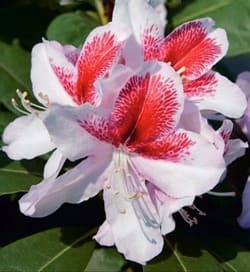










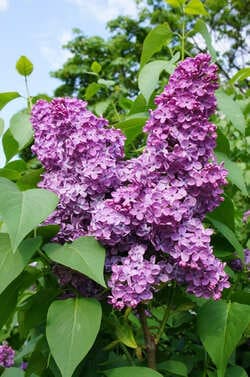

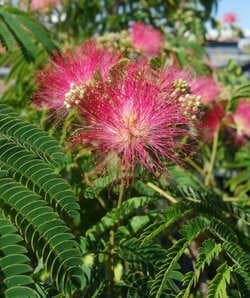







.jpg)
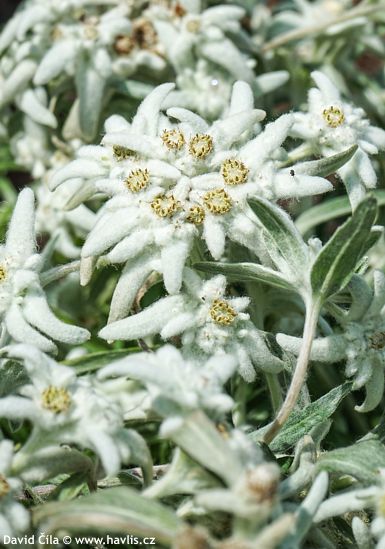
.jpg)
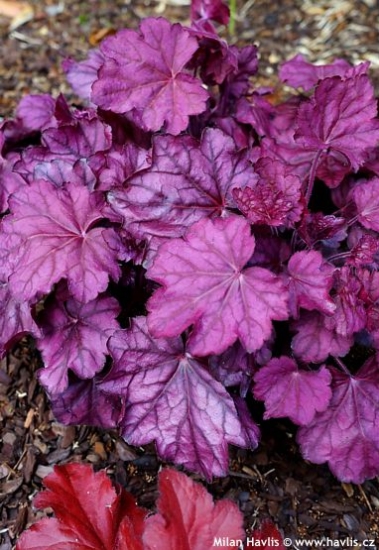
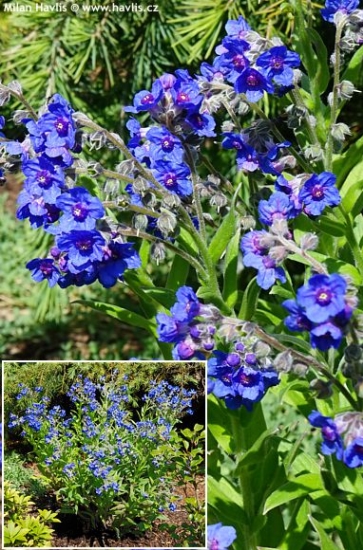
.jpg)
.jpg)
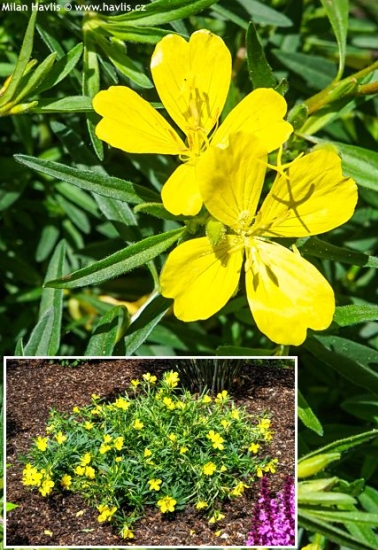
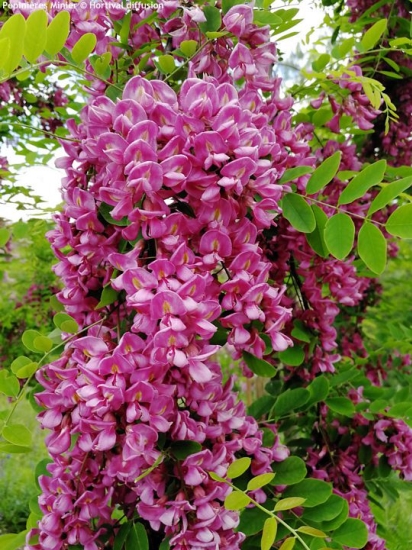
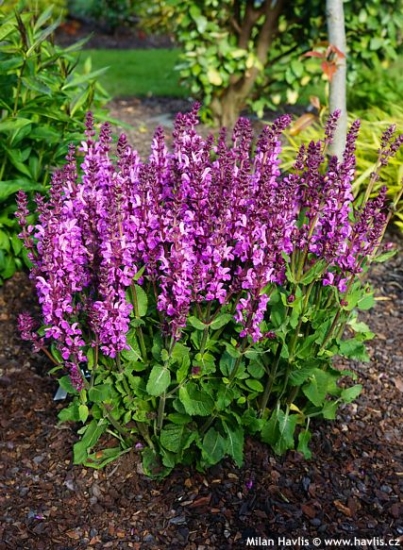
.jpg)
.jpg)
.jpg)
.jpg)
